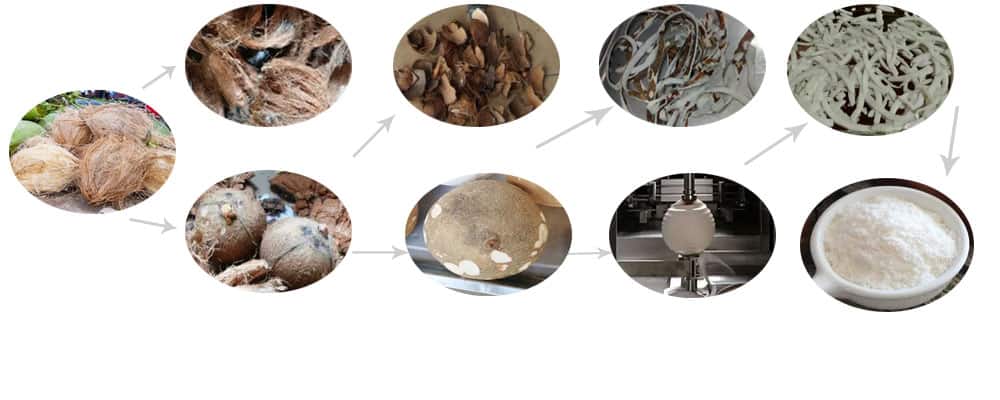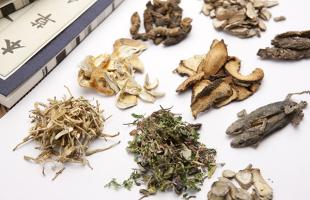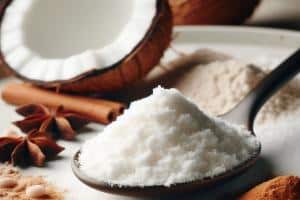Table of Contents
Coconut powder VS coconut milk powder VS coconut flour overview
Coconut powder, coconut milk powder, and coconut flour are three popular products derived from coconut meat, but they have different characteristics, uses, and nutritional values. This article will introduce and compare these three products in details.

Coconut powder VS coconut milk powder VS coconut flour difference
Coconut Powder:
Composition: Coconut powder is usually made from drying and grinding unsweetened dried coconut flakes. It is often desiccated coconut, which means the moisture content has been removed.
Nutrient content: It has a high fat content and a mildly sweet coconut taste.
Texture: Coconut powder typically has a coarse texture and is often used as a topping or ingredient in desserts, curries, and other dishes.
Usage: It can be used for recipes that require moist and rich coconut flavor, such as desserts, curries, or smoothies. It adds a coconut flavor and texture to dishes but doesn’t have the same absorbent properties as coconut flour.
Price Range: Coconut powder is often relatively affordable. It is commonly available in bulk or smaller packages. Prices may vary, but it’s generally considered a cost-effective option
Coconut milk powder
Composition: Coconut milk powder is made by spray-dried coconut milk. It often contains added ingredients like maltodextrin to improve solubility.
Nutrient content: It has a lower fat content and a higher moisture content than coconut powder.
Texture: Coconut milk powder is a fine powder that, when mixed with water, reconstitutes into coconut milk.
Usage: It can be reconstituted with water to make coconut milk or cream, provides a convenient and shelf-stable alternative to canned coconut milk. It’s versatile and can be used in both sweet and savory dishes.
Price Range: Coconut milk powder is typically more expensive than coconut powder. The added spray drying processing to transform coconut milk into a powder form, as well as potential additives, can contribute to the higher cost.
Coconut Flour:
Composition: Coconut flour is a product made from dried coconut pulp that is leftover from coconut milk production.
Nutrient content: It has a low fat content and a high fiber and protein content, gluten-free and low-carb.
Texture: Coconut flour has a very fine texture and is highly absorbent. It absorbs a lot of liquid and adds moisture to baked goods.
Usage: Coconut flour is commonly used as a substitute for wheat flour in gluten-free and paleo baking, with some adjustments. It’s suitable for pancakes, muffins, and other recipes. Due to its absorbent nature, it requires additional liquid in recipes.
Price Range: Coconut flour tends to be more expensive compared to coconut powder. The process of drying and finely grinding coconut meat into a flour-like consistency can increase production costs, influencing the overall price
As you can see, coconut powder VS coconut milk powder VS coconut flour have different properties and purposes, and they are not interchangeable in the kitchen. You should choose the one that suits your recipe and dietary needs best. I hope this helps you understand the differences between them.
Coconut powder VS coconut milk powder VS coconut flour production process
To make coconut powder, coconut milk powder and coconut flour, the process and machines are different.
To make coconut powder:
Coconut husker – coconut shell remover – coconut peeler – coconut meat washing cleaning – coconut slicer – food dehydrator – coconut powder grinder – powder filler
To make coconut milk powder:
Coconut meat extractor – coconut grater- coconut milk extractor – filter and concentrator – coconut milk spray dryer – spray dried coconut milk powder filling machine
To make coconut flour:
Coconut milk extractor – food dehydrator – fine powder grinder – powder filler
Coconut powder VS coconut milk powder VS coconut flour market prospect
Products like coconut powder, coconut milk powder, and coconut flour align with the broader consumer trends towards healthier and natural food options. Their nutritional profiles, including being gluten-free and often rich in fiber and healthy fats, contribute to their appeal. With growing demand for plant-based, gluten-free, and dairy-free foods, the market prospects for these coconut-based products are promising.
According to a report by Fortune Business Insights, the Malaysia culinary coconut milk market size was valued at USD 71.96 million in 2022 and is projected to grow to USD 129.43 million by 2030, exhibiting a CAGR of 7.81% during the forecast period.
Ongoing innovation in the food industry may introduce new products and formulations, expanding the market for coconut-based ingredients. This includes the development of new recipes and formulations that incorporate these coconut products.
As you can see, coconut powder VS coconut milk powder VS coconut flour have different properties and purposes, and they are not interchangeable in the kitchen. You should choose the one that suits your recipe and dietary needs best. I hope this helps you understand the differences between them.









